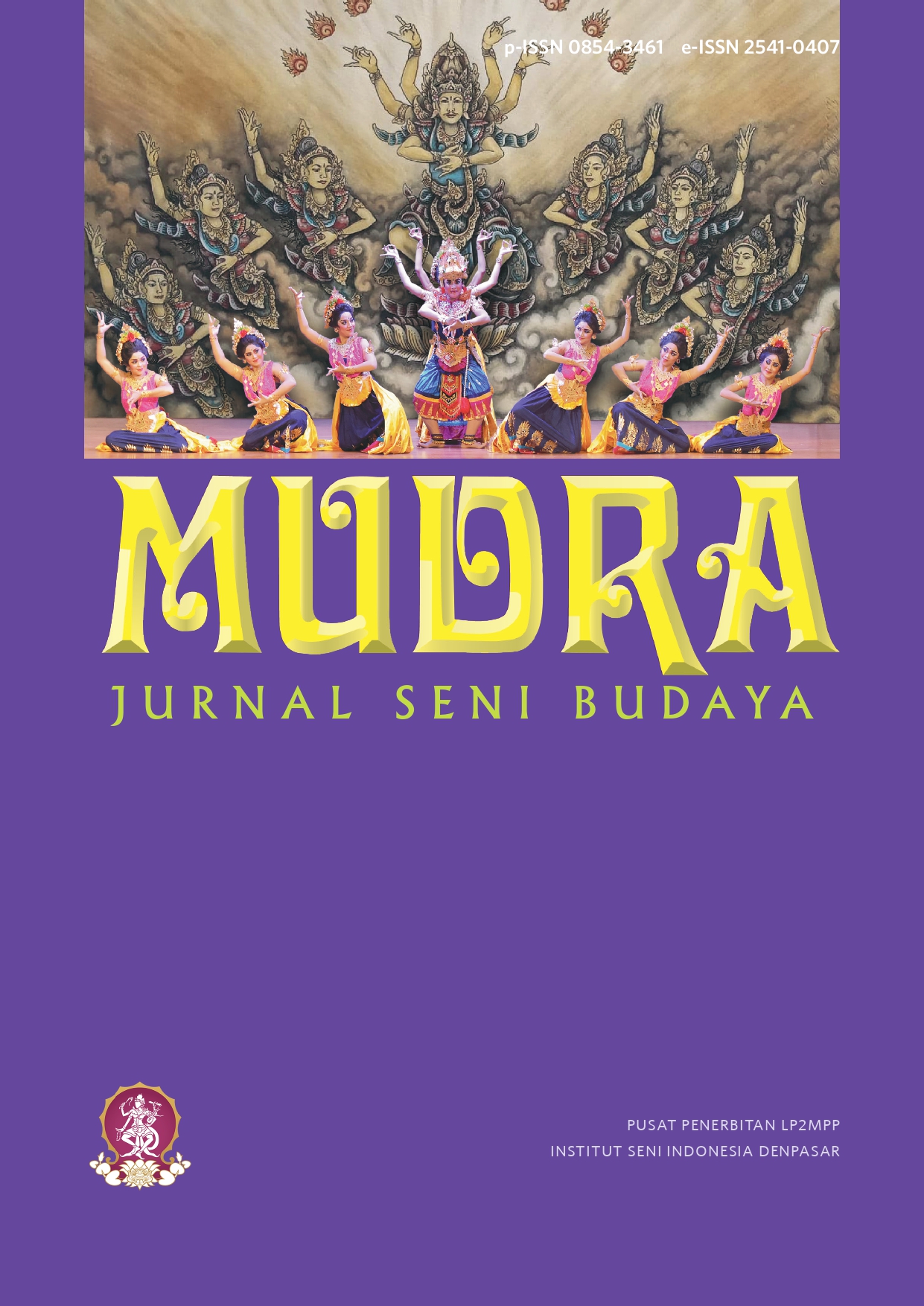Cultural Materialism and Aesthetic Analysis of Ikat-Woven Sarong Production in Parengan Village, Lamongan, East Java
DOI:
https://doi.org/10.31091/mudra.v40i4.2998Keywords:
Parengan Weaving Industry Center, Sarong Ikat Weaving, Material Culture Biography, Product FunctionAbstract
This research investigates the cultural and aesthetic dimensions of ikat-woven sarong production in Parengan Village, Lamongan Regency, East Java, using a material culture biography approach. The research addresses how traditional sarongs—particularly those with legendary patterns such as tempean, botolan, and putihan—function as cultural commodities shaped by communal production, religious practice, and regional identity. Drawing on Raymond Williams’ theory of cultural materialism and Edmund Burke Feldman’s aesthetic theory, the research analyzes the visual structure, motif repetition, and socio-cultural functions of the sarong as both a physical object and a symbolic medium. Data were collected through ethnographic fieldwork, including interviews, visual documentation, and observations in representative weaving centers. The findings reveal that sarong production in Parengan is not only a site of artisanal heritage but also a dynamic cultural practice influenced by commodification, Islamic traditions, and intergenerational knowledge transmission. The research contributes to the discourse on material culture by demonstrating how textile production reflects broader social transformations and cultural negotiations. It highlights the importance of integrating visual analysis and cultural theory to understand the evolving meaning and function of traditional craft in contemporary society.
Downloads
References
S. Kartiwa, Tenun Ikat=Indonesian Ikats. Jakarta: Djambatan, 1987.
M. Mohamed, “The Origins of Weaving Centres in the Malay Peninsula,” Malaysian Branch R. Asiat. Soc., vol. 68, no. 1, pp. 91–118, 2014.
R. Maxwell, Textiles of Southeast Asia Tradition, Trade and Transformation. Canberra: Oxford University Press Australia, 1990.
A. Kusrianto, Sarung Tenun Indonesia. Sleman: Penerbit Andi, 2020.
G. Benny and A. Judi, Tradisi Tenun Ikat Nusantara. Jakarta: BAB Publishing Indonesia, 2016.
Dinas Perindustrian dan Perdagangan Kabupaten Lamongan, “Sentra Industri yang ber-SK di Kabupaten Lamongan Sampai Desember 2020,” Dinas Perindustrian dan Perdagangan Kabupaten Lamongan. Accessed: Sep. 11, 2022. [Online]. Available: https://lamongankab.go.id/disperindag/post/4936
P. G. Blasco and H. Wardle, How to Read Ethnography. London: Routledge, 2007.
R. Williams, Culture. Netherlands: Fontana Publishers, 1981.
E. B. Feldman, ART as Image and Idea. New Jersey: Prentice Hall, Inc, 1967.
S. Gustami, Seni Kerajinan Mebel Ukir Jepara: Kajian Estetik Melalui Pendekatan Multidisiplin. Yogyakarta: Kanisius, 2000.
W. Yudoseputro, Jejak-Jejak Tradisi Bahasa Rupa Indonesia. Jakarta: Yayasan Seni Visual Indonesia, 2008.
R. Maxwell, Sari to Sarong. Canberra: National Gallery of Australia, 2003.
S. Kartiwa, Ragam Kain Tradisional Indonesia Tenun Ikat. Jakarta: PT Gramedia Pustaka Utama, 2007.
U. Mohan, “Historical and Contemporary Connections Between Indian and Indonesian Textiles: A Focus on Double-Ikat Patola,” in 7th ASEAN Traditional Textile Symposium, 2019.
B. P. S. K. Lamongan, Kecamatan Maduran Dalam Angka 2021. Lamongan: BPS Kabupaten Lamongan, 2021.
Langi, P. Kezia-Clarissa, and Shinmi, "An Analysis on Characteristics of Ancient Indonesian Textiles (II) : Focus on the Techniques and the Patterns of the 'Sacred Cloths,'" J. Korean Soc. Costume, vol. 66, no. 7, pp. 34-49, 2016.
Guntur, “Alas and Gunung: Their Representation in the Javanese Traditional Batik,” Arts Des. Stud. IISTE, vol. 27, 2015, doi: ISSN 2225-059X.
H. Morphy and M. Perkins, The Anthropology of Art. Victoria: Blackwell Publishing Ltd., 2006.
van der Hoop, Indonesische Siermotieven (Ragam-Ragam Perhiasan Indonesia). Batavia: Batavia Genootschap, 1949.
J. Bennett, "Ilm or fashion? The question of identity in the batik designs of Java," in Ilm: Science, Religion and Art in Islam, S. Akkach, Ed., University of Adelaide Press, 2019, pp. 157–180.
W. M. Webb, The Heritage of Dress Being Notes on the History and Evolution of Clothes, Revised. London: The Times Book Club, 1912.
H. A. Moisley, “Rayon Industry In Great Britain,” Geography, vol. 34, no. 2, pp. 78–89, 1949.
A. Heryanto, Identitas & Kenikmatan: Politik Budaya Layar Indonesia. Jakarta: Kepustakaan Populer Gramedia, 2015.
I. Woodward, Understanding Material Culture. London: Sage Publication Ltd, 2007.
A. Catherine, “THE SECRET LIFE OF SARONGS,” J. Mater. Cult., vol. 12, no. 1, pp. 22–46, 2007.
Downloads
Published
How to Cite
Issue
Section
License
Copyright (c) 2025 Okta Viviana Asmi Nusantari, Rr. Paramita Dyah Fitriasari, SP. Gustami

This work is licensed under a Creative Commons Attribution-NonCommercial-ShareAlike 4.0 International License.
- Copyright on any open access article in a journal published by Mudra Jurnal Seni Budaya is retained by the author(s).
-
The Creative Commons Attribution License 4.0 formalizes these and other terms and conditions of publishing articles.










